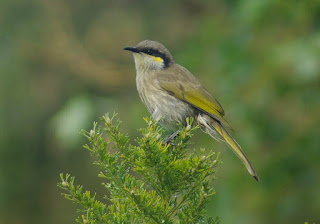The male Musk Duck is the largest of Australia's ducks and has a powerful build. Musk Duck get their name from the strong musk odour produced from the gland on the rump.
The female is smaller than the male, both are sooty-brown in plumage, with paler brown barring on the body and fine spots of the head.
They are paler below, becoming whiter towards the abdomen. The male is decorated with a large bulbous lobe of skin hanging under his bill. This sac increases in size at the start of the breeding season. The female also has much-reduced lobe on the underside of its bill, only visible at a short distance.
The bill is dark gray at the both sexes and the aye dark brown, a tail is the collection of long, stiff feathers which can be held in a fan-shape.
Young Mask Duck are similar to the adult female, but are paler, with a dull yellow tip on bill, and no lobe.
Musk Ducks are found only in Australia. They range from the north-west Western Australia, through the south and east to southern Queensland, and can be found several hundred kilometres inland in some areas.
Musk Duck tend to be found in deep freshwater lagoons, with dense reed beds. They are normally seen singly or in pairs, but may form medium to large groups in the winter.
Flight usually takes place at night.The bird's bulky-size means a large distance is required for take-off and the landing is quite clumsy.
Photos taken: 1,2 Herdsman lake
Samec je največji v vrsti Avstralskih rac in ima močno grajeno telo. Ptica je dobila ime po močnem mošusovem vonju iz zadnjične žleze.
Samica je manjša od samca. Oba imata sajasto-rjavo perje z bledo rjavimi progami po telesu in lepimi lisami na glavi. Oba sta bleda na spodnjem delu telesa in skoraj bela med trebuhom in repom.
Samec je okrašen z gomoljastim izrastkom na koži, ki mu visi pod kljunom. Mešiček se poveča v času paritvene sezone pri samici pa se precej zmanjša membranica na spodnjem delu kljuna, kar pa je vidno samo od blizu.
Kljun je temno siv pri obeh spolih in oba imata temno rjave oči. Rep je kombinacija dolgih otrdelih peres katere so lahko sprijete v spiralasto obliko.
Mladiči so podobni odrasli samici z razliko, da so bolj bledi z blago rumenim odtenkom na konici kljuna in brez za samico značilne membranice na spodjem delu kljuna.
To vrsto race je mogoče najti samo v Avstraliji. Njihov teritorij je od severozahoda Zahodne Avsralije, jug in vzhod Avstralije vse do južnega Queenslanda in jih je mogoče najti na nekaterih področjih nekaj sto kilometrov v notranjosti celine.
Njihov življenski prostor so bolj ali manj globoke sladkovodne lagune z gosto poraščenimi ležišči.
Večinoma jih je opaziti same ali v parih, v zimskem času pa se lahko združijo v srednje velike in velike skupine.
Letijo večinoma ponoči. Zaradi močno grajenega telesa rabijo veliko prostora za vzlet, pristanek pa je zelo okoren.






























